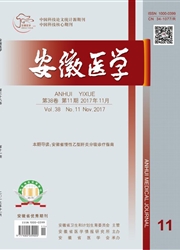

 中文摘要:
中文摘要:
目的检测B7-H4分子在狼疮性肾炎(LN)患者肾脏组织及血清中的表达。方法收集90例LN患者,急性肾外伤患者3例,20例无肾炎的SLE患者和健康体检者20例,SLEDAI评分评估LN的疾病活动性。16例LN患者接受肾活检和肾脏病理检查,免疫组织化学染色检测肾脏病理组织中B7-H4抗原表达;ELISA法检测LN患者和健康体检者血清中的可溶性B7-H4(soluble B7-H4 sB7-H4)的含量,并分析LN患者sB7-H4和临床指标的相关性。结果免疫组织化学染色显示B7-H4抗原表达于肾小管上皮细胞胞浆中,LN患者切片中5个视野下平均B7-H4阳性肾小管数百分比(45±16)%明显低于对照人群(86±11)%(P﹤0.05),并且和肾脏组织中的肾小管间质损害积分明显负相关(r=-0.476,P=0.02)。LN患者sB7-H4含量为(58.20,中位数)ng/ml、(70.57±27.24)ng/ml、(69.12±29.31)ng/ml三者之间均差异无统计学意义,与正常对照(70.57±27.24)ng/ml和无肾炎的SLE患者无明显差异,其和SLEDAI明显正相关(r=0.353,P=0.005)。另外,LN高度活动组sB7-H4含量(74.40±31.95)ng/ml明显高于中度活动组(51.89±21.79)ng/ml(P=0.017)。结论 LN患者中B7-H4分子的表达可能参与了LN的疾病进展,但其具体机制尚需要进一步阐明。
 英文摘要:
英文摘要:
Objective To investigate the expression of B7 - H4 on renal tissue and serum in the patients with LN. Methods A total of 90 LN patients, 3 acute kidney injury patients, 20 SLE patients without nephritis and 20 healthy donors were referred. Disease activity was assessed by SLEDAI scores. The expression of B7 - H4 on kidney biopsies from patients with LN and acute kidney injury was measured using immunohistochemistry. The sB7 - H4 of serum in LN and healthy donors was analysed using ELISA, and the correlation between sB7 - H4 of serum in LN with clinical data was analysed too. Results Immunohistologieal staining revealed that B7 - H4 antigen expressed on tubular ep- ithelium, the percentage of B7 - H4 positive expression renal tubules from LN patients(45 ± 16) % was lower than that from acute kidney in- jury patients ( 86 ± 11 ) % ( P 〈 0.05 ), and was negatively correlated with the index of tubulointerstitial damage ( r = - 0. 476, P = 0.02 ). The sB7 - H4 in serum of LN patients (58.20 ng/ml ,median) was not significantly lower than that of healthy controls(70.57± 27.24 ng/ml), but was strongerly associated with SLEDAI with LN (r = 0.353 ,P = 0. 006). Besides, the mean concentration of sB7 -H4 level in high ac- tivity group (74.40 ± 31.95 ng/ml) was significantly higher than that in moderate group (51.89± 21.79 ng,/ml) (p = 0. 017 ). Conclusion The expression of B7 - H4 molecules probably has effects during the progress of LN, and a clear understanding of its functional roles may further elucidate the pathogenesis of this disease.
 同期刊论文项目
同期刊论文项目
 同项目期刊论文
同项目期刊论文
 期刊信息
期刊信息
